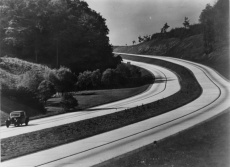Modernism
From The Art and Popular Culture Encyclopedia
_by_Édouard_Manet.jpg)


|
Related e |
|
Featured: |
- The rise of cinema and "moving pictures" in the first decade of the 20th century gave Modernism an artform which was uniquely its own, but it was largely undervalued by the literary and art intelligentsia. --Sholem Stein on modernist film
Modernism is a artistic and cultural movement which has its roots in mid-19th century France, generally defined by new forms of art, architecture, music and literature emerging in the decades before 1914 as artists rejected 19th century artistic traditions such as romanticism.
High modernism is the golden age of modernism. It peaked from 1910 to 1930.
In music, it was characterized by atonality, in architecture by the lack of ornament, in literature by the stream of consciousness technique and the lack of chronological narrative and finally, in the visual arts by lack of representation and figuration. Generally, Modernists celebrated novelty and innovation and shunned mass culture.
Some see Modernism as an ongoing development (Richard Kostelanetz), others (Stephen Bayley and John Carey) as a distinct era of ephemeral taste. It can be argued that architectural modernism died with the demolition of the Pruitt-Igoe buildings in 1972, design-modernism died in 1981 with the formation of the Memphis Design Group.
Compare modern and modernity
Character
Modernism is a tendency rooted in the idea that the "traditional" forms of art, architecture, literature, religious faith, social organization and daily life had become outdated; therefore it was essential to sweep them aside. In this it drew on previous revolutionary movements, including liberalism and communism. Modernism encouraged the re-examination of every aspect of existence, from commerce to philosophy, with the goal of finding that which was "holding back" progress, and replacing it with new, and therefore better, ways of reaching the same end. In essence, the modernist movement argued that the new realities of the industrial and mechanized age were permanent and imminent, and that people should adapt their world view to accept that the new equaled the good, the true and the beautiful.
See: neophilia
See also
- Anti-modernism
- Deviant modernism
- Modern architecture
- Modern art
- Modernist architecture
- Medium specificity
- International style (architecture)
Further reading
Listed chronologically
- The Painter of Modern Life (1863) - Charles Baudelaire
- The Work of Art in the Age of Mechanical Reproduction (1935) by Walter Benjamin
- Five Faces of Modernity (1977|1987) by Matei Calinescu
- The Culture of Time and Space, 1880-1918 (1983) - Stephen Kern
- The Intellectuals and the Masses (1992) by John Carey
- Decadence and the Making of Modernism (1996) - David Weir
- Deviant Modernism: Sexual and Textual Errancy in T.S.Eliot, James Joyce and Marcel Proust (1999) - Colleen Lamos
- Bad Modernisms (2006) by Douglas Mao and Rebecca L. Walkowitz
- Modernism, Mass Culture, and the Aesthetics of Obscenity (2000) - Allison Pease
- The First Moderns : Profiles in the Origins of Twentieth-Century Thought (1998) - William Everdell
- Sex Drives: Fantasies of Fascism in Literary Modernism (2002) - Laura Catherine Frost
- The Senses of Modernism (2002) by Sara Danius


